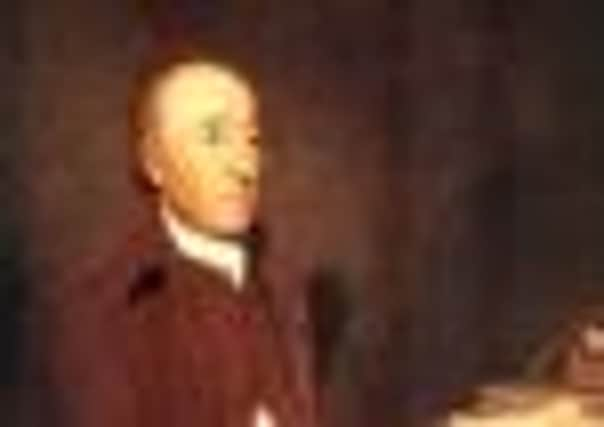‘Modern geology… I am your father’: Star Wars-style exhibition dedicated to Scot’s groundbreaking theory


But for centuries James Hutton’s achievements have been marked by little more than a simple plaque hidden near the volcanic Scottish landscape which inspired his epic Theory of the Earth.
Now, the eminent 18th-century geologist and thinker is to become the star of a new gallery within sight of the crags where he carried out much of his groundbreaking work.
Advertisement
Hide Ad

Special effects from two of the world’s most popular blockbuster film series, Harry Potter and Star Wars, are to be adapted and incorporated into a permanent exhibition dedicated to Hutton in Our Dynamic Earth (ODE), the tourist attraction at the foot of Arthur’s Seat and Salisbury crags in Edinburgh.
A “time machine” is also being constructed to transport visitors billions of years back in time to see how the Earth was formed.
Hutton, who was the first to discredit beliefs that the world was only a few thousand years old, will take centre stage in hologram form in a recreation of a classroom from Scotland’s Golden Age of Enlightenment.
His ideas will be drawn on giant blackboards as he “speaks” to visitors and discusses ideas with animated portraits of the renowned scientists, such as Charles Lyell, who built on his ideas in Scotland through the centuries.
A hi-tech display will also be created to demonstrate the modern theory of plate tectonics, which is founded on Hutton’s revolutionary discovery that rocks are formed over millennia. It was this time-scale that helped Darwin develop his own revolutionary theories on how life on Earth had evolved.
The project, which will replace the introductory hall at ODE, has received £61,500 from the Heritage Lottery Fund for its creators to develop their ideas. It is also on course to receive a additional £590,000 after passing the first round of the lottery application process, and could be open as soon as 2014.
Advertisement
Hide AdThe gallery is being created by Professor Stuart Monro, ODE’s scientific director, and award-winning Edinburgh design company Studio MB, which has worked on numerous attractions including an exhibition at the Tower of London.
Monro said: “I criticise myself for not giving sufficient emphasis to Hutton’s role in the original design of Dynamic Earth.
Advertisement
Hide Ad“All we have are a few plaques here, a little street opposite called Hutton’s Way and another plaque near his home behind where the Dumbiedykes flats are now. That’s where he came up with his theories, inspired by walking on the crags and his time farming in Berwickshire.
“He deserves much better. He is the man who gave us geological time. He looked at the rocks and realised that mountains were made because they had been squeezed and pushed up, and that the earth must be much older than 6,000 years. It was a tipping point in geological understanding.”
Charlie Barr, director of Studio MB, said: “Visitors will be transported straight back to the great age of the Enlightenment, where they will be greeted by a full-size hologram of James Hutton, like the holographic figure of Princess Leia in the original Star Wars film saying ‘Help me, Obi-Wan’.
“He will be standing at a desk in an 18th-century classroom and as he talks about his theories, chalk drawings will be ‘magically’ drawn on giant blackboards behind him.
“There is also a nod to Harry Potter in moving portraits on the classroom wall of some of the key people who took Hutton’s ideas forward. The idea is that they will all ‘come alive’ and interact with the hologram of Hutton to discuss their theories about the Earth.”
The project was welcomed by the Edinburgh Geological Society, which said it was delighted that “one of its own” was finally getting the recognition he deserved.
Advertisement
Hide AdPresident Dr Graham Leslie said: “Anything which celebrates the status that James Hutton has in the geological world has to be applauded. He is someone that we should be making a fuss over.
“All the evidence for geology is hidden beneath the surface of the earth and the enormously-long timescales are also difficult to communicate. Only perhaps with modern media can we bring much more of geological science to life.”
Hutton profile
Advertisement
Hide AdBORN in Edinburgh in 1726, Hutton studied medicine and chemistry at the universities of Edinburgh, Paris, and Leiden, in the Netherlands, but it was running farms in the Borders for 14 years that gave rise to his obsession with how the land was formed.
Around 1768, he moved to Edinburgh and studied the city’s geological formations. In 1788, he presented a paper to the Royal Society of Edinburgh, describing a universe very different from the Biblical cosmos.
The impact of his portrait of an ancient, dynamic planet had on the thinkers who followed in the next century was profound. Charles Darwin was well acquainted with Hutton’s ideas, which provided a timeframe for the biological evolution he observed in the fossil record.